Bisexual Tropes We’d Like To Yeet Into The Sun
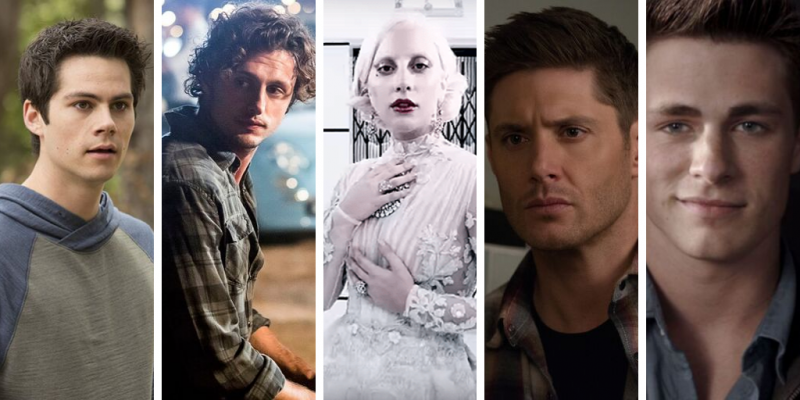 If there’s one thing that really grinds my gears it’s lazy writing. The worse offenders seem to be showrunners who are trying to shoehorn representation into something without actually knowing much about the subject. I applaud their interest in diversity- but sometimes, bad representation is worse than no representation. To mark the end of #BiWeek, here are a few bisexual tropes I would like to see die a fast, unlamented death.
If there’s one thing that really grinds my gears it’s lazy writing. The worse offenders seem to be showrunners who are trying to shoehorn representation into something without actually knowing much about the subject. I applaud their interest in diversity- but sometimes, bad representation is worse than no representation. To mark the end of #BiWeek, here are a few bisexual tropes I would like to see die a fast, unlamented death.
Here’s our ‘Bisexual Tropes We’d Like to Yeet into the Sun’ List!
Bisexuality Is Only A Transition Tool
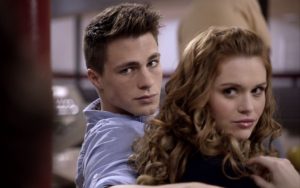 One of the weirdest bisexual tropes revolves around the misconception that there is no middle ground between straight and gay. Once a character has shown interest in a same-sex union they’re treated as 100% gay, even if they haven’t accepted it yet.
One of the weirdest bisexual tropes revolves around the misconception that there is no middle ground between straight and gay. Once a character has shown interest in a same-sex union they’re treated as 100% gay, even if they haven’t accepted it yet.
We get it, some queer folks pass through Bi Town on their way to their final destination. But for lots of people, being bi is their destination. They’re not confused (well, not any more than everyone else). They aren’t waiting to “go all the way gay” or “get over their confusion and go straight again.”
Take a look at Jackson Whittemore of Teen Wolf. He had a very real, very intense relationship with Lydia Martin that was enough to save him when he was a kanima. However, in the season finale he shows up with a shiny new boyfriend in the form of Ethan and Lydia is stoked that he “figured it out.” WHAT? Figured what out? He cared romantically about Lydia, so much it was magically significant, and now he cares about a dude. That means bisexual, not “oh you figured out you’re gay, woohoo!”
Not cool, guys.
Evil Bisexuals
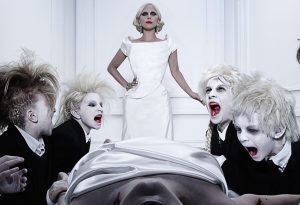 We all love a stylish queer villain, but way too often bisexuality is used as a way to demonstrate or exaggerate a baddie’s duplicity. Being bisexual comes along with being deceptive, manipulative, or even murderous- because of course, anyone who “switches sides” so often is clearly Up To Something.
We all love a stylish queer villain, but way too often bisexuality is used as a way to demonstrate or exaggerate a baddie’s duplicity. Being bisexual comes along with being deceptive, manipulative, or even murderous- because of course, anyone who “switches sides” so often is clearly Up To Something.
There are SO MANY Evil Bisexuals in pop culture: Catherine Tramell from Basic Instinct, Logan Delos from Westworld, Frank Underwood from House of Cards. The season premiere of American Horror Story: Hotel has a male-female couple seducing another male-female couple, then literally murdering them and drinking their blood.
In all these cases bisexuality isn’t just a character trait. It’s intentionally used to lend an aberrant flavor to the character. Like, it’s so weird and unnatural to be bisexual, they must also be into other weird and unnatural things, right?
Wrong! Bi peeps have just as much potential for good or evil as others. Stomp this trope into the ground now, please.
Ambiguously Bisexual People (AKA Bi-baiting)
This is a less a distinct trope and more a subcategory of queerbaiting. A character is very strongly coded as bisexual, to include art direction, character beats, and same-sex flirtations later played off as jokes. This is used to stir up the LGBTQIA+ fans (who are famously good at keeping the show’s profile up through fan fiction, art, and fanvids) without risking pushback from more conservative fans.
Real talk: this is more than lazy- it’s cowardly. Creators who want credit for a bisexual character without actually letting the character be visibly bi are part of what’s wrong with queer representation in Hollywood. Sometimes they try to justify this with a lame excuse like, “He doesn’t see gender” or “She’s really all about connections,” but that doesn’t hold water if they’re only allowed to have relationships outside their gender identity. Other times the character is so strongly queer-coded literally no one would be surprised no matter who they kiss, and the showrunners wave it off with, “He’s straight, he’s just, like, really comfortable with people, you know?”
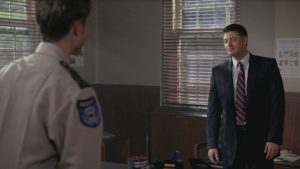
Probably the best example of bi-baiting running right now is Dean Winchester from Supernatural. (I know, I know, The Geekiary doesn’t cover the show anymore. That doesn’t mean he’s not the absolute perfect example.) It’s been thankfully toned down a shade over the years, but even if you ignore the blatantly romantic storylines he’s given with a certain blue-eyed angel, Dean is seriously bi-coded. There are lots of times he checks out a dude, or is adorably flustered when a guy flirts with him. Artistic choices around him even support the narrative- he’s once positioned in front of lights in the distinctive bi-pride colors. More than once his laptop screen is lit up in bi-pride colors. It’s a running thing.
These aren’t accidents. Design and script choices like this go through many people and many versions before anything makes it onto the screen. The thing is, Dean would probably be more popular with fans as an out and proud bi dude, so who knows why they don’t let him out of the closet? (My guess? The overseas Supernatural market is worth a lot and they don’t want to risk losing those fans.)
Whatever the reason, bi-baiting has somehow strengthened as queer-baiting is starting (barely!) to lose ground.
Rip this one out by the roots!
The Geekiary Team had a few additions to my Bisexual Tropes Burn Pile, too:
Using Stereotypical Bisexuality for Messy Drama (Farid)
 One of the most damaging bisexual stereotypes is bisexual promiscuity. Because bisexual attraction isn’t confined to one specific gender, others believe bisexuals are unable to commit to a single relationship and thus, can’t be trusted.
One of the most damaging bisexual stereotypes is bisexual promiscuity. Because bisexual attraction isn’t confined to one specific gender, others believe bisexuals are unable to commit to a single relationship and thus, can’t be trusted.
The CW’s Roswell, New Mexico is an unfortunate example of this. The show features Michael’s bisexuality being used to create a messy love triangle involving him, a POC gay guy (Alex), and a WOC (Maria).
The show has been renewed for a second season. So, let’s what showrunner Carina Adly McKenzie decides to do.
Actors Not Realizing They’re Playing Bisexual Characters (StickyKeys)
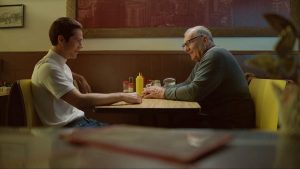 YouTube Premium’s Weird City (created by Charlie Sanders and Jordan Peele) debuted with an episode featuring a bisexual romance. While Sanders writing is a good example of how diversity can be included without tokenism, the premiere episode got into a bit of drama because of the relationship between Burt (Ed O’Neill) and Stu (Dylan O’Brien).
YouTube Premium’s Weird City (created by Charlie Sanders and Jordan Peele) debuted with an episode featuring a bisexual romance. While Sanders writing is a good example of how diversity can be included without tokenism, the premiere episode got into a bit of drama because of the relationship between Burt (Ed O’Neill) and Stu (Dylan O’Brien).
Originally O’Neill went on record saying the characters were “not gay” but “lonely.” And while said with good intention, this is the kind of statement that enables enemies of progress.
No, Stu and Burt were not gay… they were bisexual, and attracted to each other physically and emotionally.
Here’s to hoping (straight) actors playing queer roles are made more aware of queer sexualities, especially when they’re promoting the content they’re in.
A Special Note From StickyKeys on Stiles Stilinski
We couldn’t talk about Dylan O’Brien’s bisexual characters without talking about Stiles Stilinski as portrayed on Teen Wolf, which aired on MTV.
In a world which, the showrunner explicitly said, was free of homophobia, Teen Wolf often displayed two-dimensional bi representation and even erasure. It was teased for seasons that Stiles was bisexual, but without on-screen confirmation. In fact, the chosen way to show bi characters was to have them making out with a guy, and then, a girl. Voila!
The fan outcry to this lack of bi-rep for Stiles was mentioned by O’Brien, saying, “Stiles isn’t gay… He’s clearly not gay… but he also looks at people as people. He doesn’t associate gay and not gay, but he knows he likes girls.”
A flood of articles came out predicting the end of Sterek and other queer Stiles-based ships on the grounds of “Dylan O’Brien says beloved character is straight!”
But that’s not quite what he said, was it? “He’s clearly not gay… but he also looks at people as people.”
Stiles is not gay… but he’s not straight either. How could he possibly be? He doesn’t see gay or not gay, he looks at people as people. Just like the wonderful bisexual he is.
–
Despite these aggravating bisexual tropes that linger like my racist uncle at Thanksgiving dinner, things are getting better. We’re seeing more queer characters (and a wider variety!) all the time. Let’s take time to recognize good representation, and maybe the worst bisexual tropes will become so unprofitable networks will stop using them.
–
Editor’s Note: Of course, similar to our bisexual comic book characters list, with bisexuality existing on a spectrum, certain characters on this list are likely to fall under the term pansexual, too (depending on interpretation).
Author: Khai
Khai is a writer, anthropologist, and games enthusiast. She is co-editor (alongside Alex DeCampi) of and contributor to “True War Stories”, a comic anthology published by Z2 Comics. When she’s not writing or creating games, Khai likes to run more tabletop RPGs than one person should reasonably juggle.
Help support independent journalism. Subscribe to our Patreon.
Copyright © The Geekiary
Do not copy our content in whole to other websites. If you are reading this anywhere besides TheGeekiary.com, it has been stolen.Read our


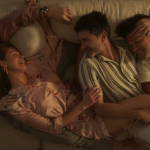

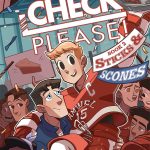
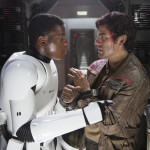

Side note here on Dean Winchester: it’s relevant BY A LOT that in canon demon!Dean does romp around with triplets and Crowley, so an argument could be made for on-screen bisexuality- but only when he was a demon, which falls under the “Evil Bi” trope.
I’ve never seen the show, so I don’t know the context, but what exactly is wrong with this:
“In fact, the chosen way to show bi characters was to have them making out with a guy, and then, a girl. Voila!”
?
I mean, I remember when exactly this happened in the first season of the revived Doctor Who series, there was a lot of cheering about it. Granted, that was in a show designed primarily for children / family audiences and Captain Jack Harkness had already been flirting with various men and women for a few episodes before that scene and he’d been introduced as “more flexible about dancing”, so maybe the context makes all the difference here? Or is it that you expected more in whatever year the Teen Wolf show aired than you did in 2005? Or is the issue that a show for teenagers should actually use the “B-word” instead of just showing instead of telling?
Well you kind of explained the issue in the rest of your statement. That was the ONLY context. He hadn’t flirted with guys or girls before and they’ve had dance scenes between two characters of the same sex, neither of whom identified as queer. Without the context it boils down the bisexual experience to just sexual intimacy (of course it was “sexy dancing” and not like, them flossing with each other) which isn’t the case with anyone, really.
So yes, expecting more and although the world was supposed to be free of homophobia that doesn’t mean it was supposed to be free of sexual identity and I think the show worked very hard to show fluidity in some characters while staunchly trying to confirm the heterosexuality of their main cast. It creates a very specific type of lazy hypocrisy that’s not fun to watch.